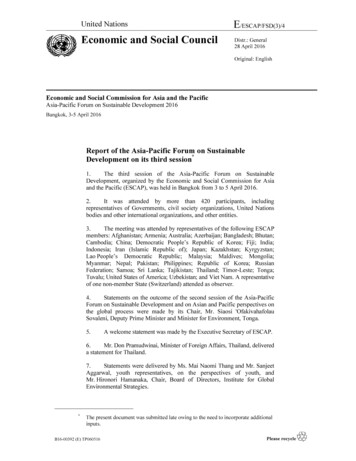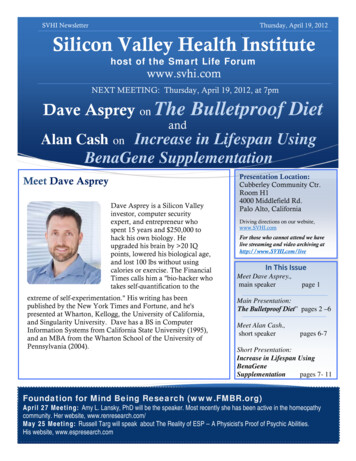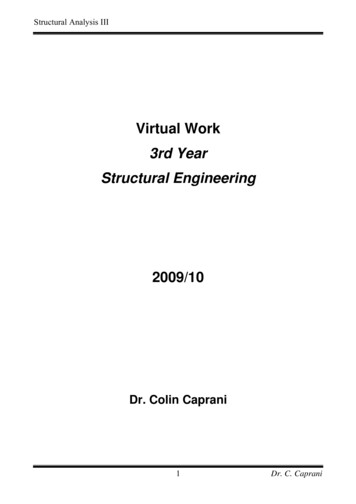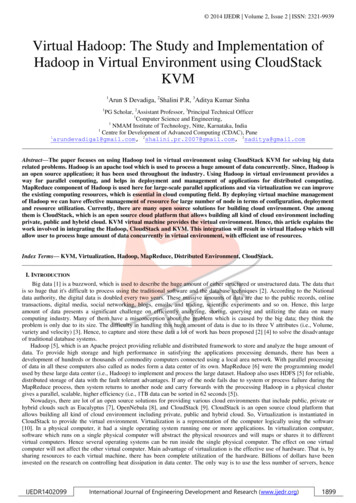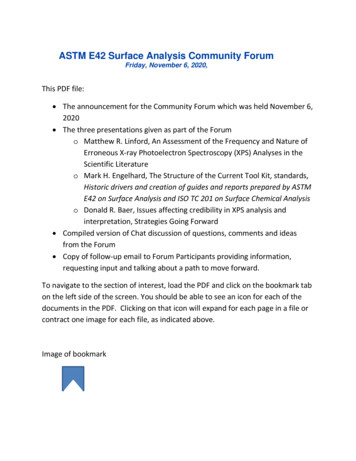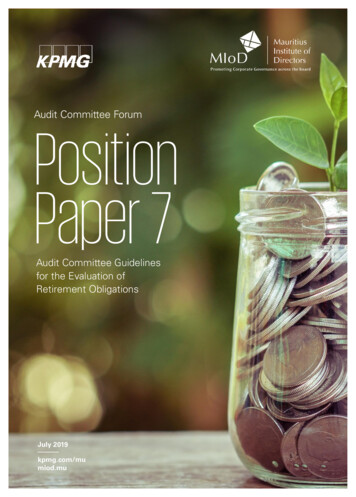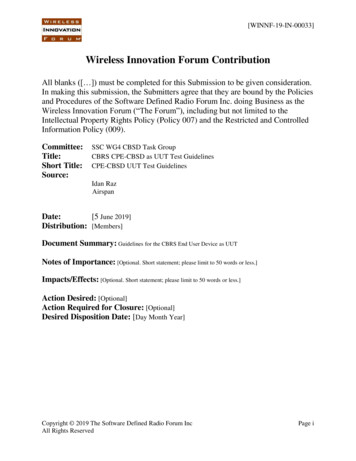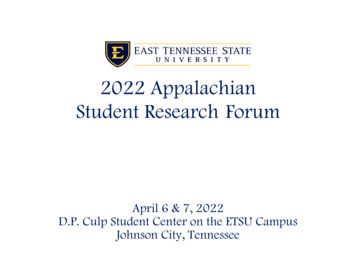
Transcription
National Aeronautics andSpace AdministrationVirtual Industry ForumUtilizing Public-Private Partnerships toAdvance Tipping Point TechnologiesNNH16ZOA001N-16STMD-001Presented by: Jim Reuter, Bonnie James STMD 7.20.2016 www.nasa.gov/spacetech
Tipping Point 2016Virtual Industry Forum - AgendaAgenda: Introduction of Presenterso Jim Reuter, STMD, Deputy Associate Administrator for Programso Bonnie James, STMD, Senior Investment Strategist Introduction: NASA Space Technology Mission Directorate (STMD) Ground Rules Objectives Background Solicitation Overview Questionso Review of submitted written Frequently Asked Questions (FAQs)o Review of anticipated updates to the Tipping Point Draft Appendix languageo Verbal questions during the Q&A period of the ForumNOTE: Questions should be submitted to the email address listed in the com2
Space Technology . an Investment for the Future Enables new NASA missions beyond low EarthOrbit. Delivers innovative solutions that dramaticallyimprove technological capabilities for NASA and theNation. Develops technologies and capabilities that makeNASA’s missions more affordable and morereliable. Engages the brightest minds fromacademia and industry, including small businesses,in solving NASA’s tough technological challenges. Invests in the economy by creating markets andspurring innovation for traditional and emergingaerospace business.Addresses National NeedsA generation of studies and reports (40 since 1980) document the need forregular investment in new,transformative space technologies.Who: The NASA WorkforceCommercial Space / IndustryAcademiaSmall BusinessesOther Government Agencypartners3
Space Technology Pipeline4
Tipping Point 2016Virtual Industry Forum - Ground RulesGround Rules: Questions and comments about anything pertaining to this solicitation,including the Virtual Industry Forum, should be submitted via email to:HQ-STMD-TippingPointAppendix@nasaprs.comNASA will make every attempt to address questions during thisteleconference to clarify the content of the solicitation.Questions that require further assessment will be resolved as soon aspossible after the Forum, and the answers will be posted to the FrequentlyAsked Questions (FAQ) page on NSPIRES.The Q&As outlined in the FAQs on NSPIRES take precedence over all verbaldiscussions. Please refer to the FAQs for official NASA responses.NASA will not provide evaluations, opinions, or recommendations regardingpotential space technology development proposals.NOTE: Charts presented today will be available on the website listed in thesolicitation: r-commercialspace-technologies5
Tipping Point 2016Virtual Industry Forum - ObjectivesObjectives: Goal/Intent of this Solicitationo NASA continues to embrace public-private partnerships to achieve itsstrategic goals for expanding capabilities and opportunities in space.o A key aspect of NASA’s strategy is to stimulate the commercial spaceindustry while leveraging those same commercial capabilities throughpublic-private partnerships to deliver technologies and capabilitiesneeded for future NASA, other government agency, and commercialmissions. Objectives of the Virtual Industry Forumo Provide an overview of the draft solicitation released June 28, 2016o Address questions from potential offerorso Prepare for the Final Appendix to be released in August6
Tipping Point 2016Virtual Industry Forum - BackgroundBackground: Definition of “Tipping Point”o For the purpose of this solicitation, a space technology is at a tippingpoint if an investment in a ground development/demonstration or aflight demonstration will result in:– a significant advancement of the technology’s maturation, and– a high likelihood for utilization of the technology in a commercialspace application, and– a significant improvement in the offerors’ ability to successfullybring the space technology to market.NASA is interested in advancing these new capabilities to a point that industrywould complete and qualify them for market without further governmentinvestments.These technologies should provide a substantial benefit to both thecommercial and government sectors once the development/demonstrationproject completes.7
Tipping Point 2016Virtual Industry Forum - BackgroundBackground (continued): Market Researcho In selecting topics, STMD considered responses received from theCommercial Space Technology Development Request for Information (RFI),other recently released RFIs, as well as existing investments within NASA’stechnology portfolio for commercial space applications.o STMD has also developed a “sister” solicitation that embraces public-privatepartnerships through U.S. industry-led technology advancement efforts, theAnnouncement of Collaborative Opportunity (ACO). Last year the TippingPoint solicitation and the ACO solicitation were released together. This year,the Tipping Point is being released in 2016 and it is anticipated that the ACOwill be released in 2017. The ACO focuses on partnership between NASA andindustry through the award of non-reimbursable Space Act Agreements(SAAs) that will accelerate the availability and reduce costs for thedevelopment and infusion of emerging capabilities.o Results of Market Research will also be utilized to inform topic selection forthe 2017 ACO solicitation.8
Tipping Point 2016Virtual Industry Forum - BackgroundBackground (continued): (2) Technology Topics for this solicitation:Technology TopicEntry TRLTopic 1: Small LaunchVehicle TechnologyDevelopment4Topic 2:Small Satellite MissionTechnologyDemonstration5AnticipatedNumber ofAwardsValue ofEach AwardPeriod ofPerformanceup to 5up to 2Mper awardup to 24 monthsup to 2up to 2.5Mper awardup to 24 monthsTipping Point Draft Appendix on epositorydocument/cmdocumentid 521093/solicitationId citationDocument 1/DRAFT%20NNH16ZOA001N-16STMD 001%206-282016.pdf9
Tipping Point 2016Virtual Industry Forum - Solicitation OverviewSolicitation Overview: Proposed efforts must be led by U.S. industry defined as for-profit businessesthat are incorporated in the United States. However, this does not preclude U.S. for-profit companies that areincorporated and operate in the U.S. and also have an affiliation with aforeign firm. NASA will not consider proposals that do not include a U.S. industry business asthe lead proposer. A lead offeror is defined as the proposing organization that will be entering into acontractual relationship with the Government. Offerors are encouraged to propose teaming arrangements that optimize thepotential for rapid development & infusion of the space technology. Teaming partners must also be U.S. domestic entities. However, this doesnot preclude teaming with U.S. for-profit companies that are incorporatedand operate in the U.S. and also have an affiliation with a foreign entity. Also,it does not preclude teaming with non-profit U.S. domestic entities thatoperate in the U.S. and also have an affiliation with a foreign entity. TheSystem for Award Management (sam.gov) will be reviewed to determine anofferor’s country of incorporation.10
Tipping Point 2016Virtual Industry Forum - Solicitation OverviewSolicitation Overview (continued): Lead offerors may act as partners on other lead proposals. However, an offerorcan only be a lead on one proposal per topic. Individual proposals may NOTcross topics. Award Details Firm-Fixed Priced contracts with milestone payments tied to technicalachievement. Key Dates to Remembero Final Appendix Release: August 10, 2016 (Target)o NOI (not required, but strongly encouraged) – due August 24, 2016o Proposals - due by 5:00pm Eastern on September 29, 2016 Submittal Processo All proposals submitted in response to this solicitation must be submitted bythe Authorized Organizational Representative (AOR) at the proposingorganization who is authorized to make such a submission.o All proposals submitted must be in electronic form. No hardcopies will beaccepted.o Please start the NSPIRES submittal process as early as possible.11
Tipping Point 2016Virtual Industry Forum - Solicitation OverviewSolicitation Overview (continued): Required Industry Contributiono For this solicitation, all proposals require an industry contribution of at least 25% ofthe total price of the project.o Contributions may be in the form of direct labor, travel, consumables or other in-kindcontributions that directly advance the objectives of the proposed effort.o Contributions coming from government organizations WILL NOT count towards the25% requirement (U.S. Government contributions may count for contributions inexcess of the 25%).o Industry contributions must:v be met during the awarded period of performancev provide for a necessary element advancing the project objectivesv be quantifiable and documentedv be incurred AFTER the period of performance start date in the contract(i.e. “Sunk” costs are NOT allowable in calculating Industry Contribution.)12
Tipping Point 2016Virtual Industry Forum - Solicitation OverviewSolicitation Overview (continued): Required Industry Contribution (continued)o Contributions of greater than 25% are strongly encouraged and willstrengthen the Price evaluation criterion.o Non-cash contribution for the project may be counted at the time-useequivalent current fair market value, even though it may have beenacquired at some point in the past.o Development costs for an item or a service that were incurred prior to theperiod of performance start date of the contract cannot be counted as acontribution.o Contributions include, but are not limited to: donated equipment/property/facilities by an external source, third party funded non-cash contributions, funding from a third party other than a government entity.13
Tipping Point 2016Virtual Industry Forum - Solicitation OverviewSolicitation Overview (continued): Proposal Contento Quad chart: this one page summary is required; specific details provided insolicitation; quad chart does not count against page limit.o Quad chart should not include restricted information (ITAR, companyproprietary, sensitive).o Quad chart template isn’t included in the solicitation, but is available ter-commercial-spacetechnologieso Technical and Management Section Relevance Technical and Management Approacheso Price Sectiono Evaluation Criteria (equally weighted)o Relevanceo Technical and Management Approacheso Price14
Tipping Point 2016Virtual Industry Forum - FAQsQuestion: Comments: Are you only accepting comments from potentialresponders or can NASA centers also provide comments?Answer: Comments are welcome from anyone.Question: Development Costs: Can development costs for the vehicle bus and/orpayloads that have been incurred prior to the period of performance be counted as acontribution for the purpose of the 25% industry cost share?Answer: Section 4.0, subparagraph 3B states: Development costs for an item or aservice that were incurred prior to the period of performance start date of thecontract cannot be counted as a contribution.15
Tipping Point 2016Virtual Industry Forum - Anticipated Language UpdatesQuestion: TRL: Both topics have an Entry TRL listed. At what point in the programdoes the technology need to be at that TRL? At the time of the proposalsubmissions? Or could a technology be considered eligible if you have a credible,funded plan for getting it to that TRL by the time of contract selection? or by the timeof start of contract?Answer: The table shown in Section 2.1 states the Entry TRL for each Topic. TheEntry TRL is defined as the minimum TRL required at time of proposal submission.NASA anticipates making a language change to the final Tipping Point Appendix.Question: Contract Value: Is “Net Price NASA Pays” (page 37) the same as “firmfixed –price contract value” (page 19)? Are these also the same as “Value of EachAward” (page 10)?Answer: “Net Price NASA Pays” (Page 37) is the same as “firm-fixed-price contractvalue” on page 19 and “Value of Each Award” (page 10). NASA anticipates making alanguage change to the final Tipping Point Appendix.16
Tipping Point 2016Virtual Industry Forum - Anticipated Language UpdatesQuestion: Options: Since the total firm-fixed-price of the proposal needs to remainwithin the constraints of the table in Section 2.1 (Page 10), but NASA is seeking tomaximize the value of its investment, is option pricing acceptable in the offer?Answer: Options are not acceptable. NASA anticipates making a language changeto the final Tipping Point Appendix.Question: Options: Can a bidder propose base scope with options that, in total, areless than or equal to the maximum award value? The intent would be to allow NASAto select portions of the development that it is interested in for funding.Answer: Options are not acceptable. The offeror should propose the full scope ofthe effort, but must stay within the maximum award value noted in the Appendix.NASA anticipates making a language change to the final Tipping Point Appendix.17
Tipping Point 2016Virtual Industry Forum - Anticipated Language UpdatesQuestion: SBIR/STTR Funding: In Section 3.5, it is stated that “selectees under thisTipping Point solicitation that have a qualifying Phase II are encouraged to also apply. for an SBIR/STTR Phase II-E or Phase II-X ” Is this limited to NASA or does itinclude DARPA, Air Force, etc. as well?Answer: Technology efforts funded through the Tipping Point solicitation may beapplicable to other government agency post Phase II initiative opportunities, but theyare managed by the respective agency’s SBIR program (DARPA, Air Force, etc.). Anyquestions on eligibility or process should be discussed directly with those agencies.NASA anticipates making a language change to the final Tipping Point Appendix.Question: Subcontractor Limits: We understand there is a limitation of oneproposal per company per topic. Is there also a limitation to the number of proposalsfor which a company can be a subcontractor to another company’s proposal?Answer: As stated in Section 3.1: “Lead offerors may act as partners on other leadproposals. A lead offeror is defined as the proposing organization that will be enteringinto a contractual relationship with the Government. However, an offeror can only be alead on one proposal per topic. Individual proposals may NOT cross topics.” There isno limitation to the number of proposals for which a company can act as asubcontractor. NASA anticipates making a language change to the final Tipping Point18Appendix.
Tipping Point 2016Virtual Industry Forum - Anticipated Language UpdatesQuestion: Topic 1: The intended end application and platform for demonstration ofour technology is focused primarily toward in-space exploration rather than a smalllauncher. Is there flexibility in this appendix to allow demonstrations on in-spaceplatforms?Answer: The scope of the topic is the development of small launch vehicletechnologies that can significantly enable the emerging small launch vehicle market.If your technology has broad applications beyond enabling frequent launches ofsmall spacecraft to LEO it would be considered within scope. However, theemphasis should be on addressing the use case described in the Topic. NASAanticipates making a language change to the final Tipping Point Appendix.Question: For Topic 1, is there any preference to either smaller scope,component/subsystem-level projects with more focus on individual technologyelement demonstrations/tests versus larger scope projects focused on full-scale,integrated system development?Answer: Both types of projects are welcome. As outlined in the Topic 1 descriptions,NASA is interested in a broad range of small launch vehicle technologies that cansignificantly enable the emerging small launch vehicle market. NASA anticipatesmaking a language change to the final Tipping Point Appendix.19
Tipping Point 2016Virtual Industry Forum - Anticipated Language UpdatesQuestion: Topic 1: At the end of the Technology Topic 1, suborbital technologydemonstrations are referenced. The wording states that purchasing these servicesare the responsibility of the offeror. Does this mean that proposers would beprecluded from proposing to the flight opportunities program for flights which mayenhance the proposed development program?Answer: Proposers to this solicitation would not be precluded from proposing to theSTMD Flight Opportunities Program opportunities or other STMD fundingopportunities. NASA anticipates making a language change to the final Tipping PointAppendix.20
Tipping Point 2016Virtual Industry Forum - Anticipated Language UpdatesQuestion: The term in Topic 2 “satellite” implies applications limited to orbiting theEarth or other bodies. Some cubesat missions could have outward bound trajectoriestoward the asteroid belt or even planned impacts. We suggest using the term “smallspacecraft”.Answer: Agreed. NASA anticipates making a language change to the final TippingPoint Appendix.Question: Topic 2: While there is mention of possible mission applications forlocations beyond Low Earth Orbit, there is no mention of the associated propulsion forthese missions, only propulsion for proximity operations and orbital maneuvers. Wesuggest adding "in-space propulsion”.Answer: Agreed. NASA anticipates making a language change to the final TippingPoint Appendix.Question: Topic 2: While there is mention of possible biological and physicalsciences missions, there is no mention of enabling technologies for samplereturn. We suggest adding "enabling technologies for sample return" in the biologicaland physical sciences missions section.Answer: Agreed. NASA anticipates making a language change to the final TippingPoint Appendix.21
Tipping Point 2016Virtual Industry Forum - Anticipated Language UpdatesQuestion: Topic 2: Page iii and page 7 state that “a space technology is at a tippingpoint if an investment in a ground development/demonstration or a flight demonstrationwill result in a significant advancement of the technology’s maturation ” However, inSection 1.3.2 Topic 2: Small Satellite Technology Flight Demonstration Mission, page 9,it is stated that the objective of this topic “ is to advance small spacecraft capabilitiesthrough a flight demonstration ” Would NASA STMD consider revising the objective ofthis topic to include ground demos as well as flight demonstrations?Answer: The objective of Topic 2 is to advance small spacecraft capabilities through aflight demonstration. A ground demonstration or non-flight demonstration only is notwithin the scope of this Topic. NASA anticipates making a language change.Question: Topic 2: The Draft appendix seems to suggest that the opportunities forintegration are primarily used for the launch vehicle but omits the specific phrasing touse the technology for deep space payload utilization. Is this considered in scope?Answer: The scope of the topic is the development of small launch vehicle technologiesthat can significantly enable the emerging small launch vehicle market. If yourtechnology has broad applications beyond enabling frequent launches of smallspacecraft to LEO, it would be considered within scope. However, the emphasis shouldbe on addressing the use case described in the Topic. NASA anticipates making a22language change.
Tipping Point 2016Virtual Industry Forum - Anticipated Language UpdatesQuestion: Topic 2: For a tech demo, do the launch and beginning of dataacquisition need to fit within the 24 month period of performance, or does thecomplete demo and data reduction need to fit?Answer: NASA anticipates making a language change to the final Tipping PointAppendix.Question: Topic 2: In reference to the 24 month period of performance-- what ifthe technology demonstration takes a long time? If the mission must be completedwithin 24 months, can an extended mission be part of our cost share?Answer: The complete industry contribution requirement must be realized duringthe maximum awarded period of performance. NASA anticipates making alanguage change to the final Tipping Point Appendix.23
Tipping Point 2016Virtual Industry Forum - Anticipated Language UpdatesQuestion: Topic 2: When you say on page 9 "Small satellite flight demonstrationsproposed under this topic should include a complete, end-to-end mission," is atechnology demonstration mission applicable? I.e., if the technologies you wantedto infuse related to cubesat propulsion, would a mission where the cubesatexecuted maneuvers similar to future missions be applicable? Or does it need to bewrapped into a more sophisticated mission involving some sort of scientific payloadin addition to the technology you're trying to demonstrate?Answer: Topic 2 pertains to a flight demonstration of a mission-capable technologysystem, not an operational mission. NASA anticipates making a language changeto the final Tipping Point Appendix.24
Tipping Point 2016Virtual Industry Forum - ConclusionPlease submit questions to the email listed in the comAnswers to questions will be posted to the FAQ page on NSPIRES:Charts presented today will be available on the website listed in the ties-to-foster-commercial-spacetechnologiesPlease periodically check this website for any further updates.The targeted release date for the final Tipping Point 2016 Appendix is August10, 2016.Thank you very much for your participation today.25
the Tipping Point is being released in 2016 and it is anticipated that the ACO will be released in 2017. The ACO focuses on partnership between NASA and . 2016.pdf 9 . Technology Topic Entry TRL Anticipated Number of Awards Value of Each Award Period of Performance Topic 1: Small Launch Vehicle Technology Development . 4
